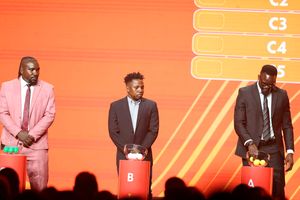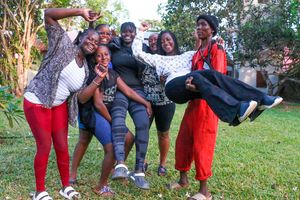
An aerial view of Nyayo National Stadium, Nairobi taken on October 16, 2012. The stadium has undergone several upgrades since its launch in 1983.
Nyayo National Stadium in Nairobi has been in the news this past few years.
It is a designated match venue for the delayed 2024 African Nations Champions but was found wanting by the CAF technical team when they announced on Tuesday the postponement of the biennial tournament to give Kenya time to complete the stadium’s upgrade.
On October 29, 2021 CAF banned Nyayo together with Moi International Sports Centre from hosting international matches because they did not meet minimum requirements to stage such fixtures.
These included condition of the playing surface, shortcomings with the floodlights, dressing rooms, medical room, press centre, stands and lack of seats.
Nation Sport looks back at how this 41-year-old stadium, the first major sporting facility built after independence, came into being. The 30,000 seater Nyayo National Stadium was actually built as an afterthought.
The government had allocated Sh5 million for Team Kenya for the 1980 Moscow Olympics but the country ended up boycotting the Games.
The boycott was part of a larger international protest against the Soviet Union for invading Afghanistan in 1979.
Moscow was the second consecutive Olympics Kenya had boycotted after it joined 21 other African countries in pulling out of the 1976 Montreal Games in protest of New Zealand rugby team’s tour of apartheid South Africa.
This was in addition to New Zealand being allowed to participate in the 1976 Games.
Athletics Kenya (AK), then Kenya Amateur Athletics Association (KAAA), chairman Sam Ongeri says that during a national athletics meet at Bukhungu Stadium, Kakamega he requested President Moi, who was in attendance to allow the funds, about Sh5 million, that were meant for the Moscow Games be channelled to build a stadium.
The President, who was an avid supporter of sports, had no problem letting the funds be used for the benefit of Kenyan sportsmen and women.
The piece of land that KAAA owned in Nairobi West happened to be the most appropriate place for the project owing to its proximity to Nairobi’s Central Business District. The story was extensively covered in the local media then.
Having read the news, an ambitious 33-year-old architecture graduate from the University of Nairobi went looking for Ongeri, who was then a lecturer at the UoN at his office that was based at the Kenyatta National Hospital.
“I approached him with some architectural design of what could become Kenya’s first modern stadium, replacing the Nairobi City Stadium,” says George Nyanja, who ran a successful architecture firm before venturing into politics.
Nyanja, who would serve as Limuru Member of Parliament from 1992 to 2002, notes that Ongeri was impressed with his work and he didn’t need a second appointment to get the nod from KAAA boss.
“This is a person I had not met before but he gave me a go-ahead to work out something. I contacted the ministry of lands and as they say, the rest is history,” said Nyanja, adding that he designed something simple but unique, leaving out room for improvement in the near future.
Just how did AK then KAAA acquire the prime land where Nyayo National Stadium lies?
Sir Derek Quicke Erskine, a British settler, who passed away in 1977, co-founded the KAAA, now AK in 1950.
As a sign of goodwill, Erskine, who was KAAA chairman from 1951, donated the land where the Nyayo National Stadium and Riadha House currently sit, to the local athletics body.
Title deed
While the government owned the stadium, AK owned the land but after the government compensated AK with another parcel of land at the vast Moi International Sports Centre (MISC), Kasarani, the transfer of the title deed was done.
A source at AK intimates that the land was split into two with the official transfer taking place three years ago. The government took the title needed for Nyayo National Stadium while AK remained with the title to the land where Riadha House is constructed in addition to the title deed at Kasarani.
Nyanja says that the construction of the Nyayo National Stadium was done in six phases.
The first phase involved the erection of the perimeter wall that was done by Vishva Builders from Eldoret at a cost of Sh2 million.
Then came the second phase, the construction of the VIP Pavilion that had a canopy whose back faces the Douglas Wakiihuri Road, formerly Aerodrome Road. It was completed alongside the laying of the tartan track in 1983 and cost Sh13.1 million according to Nyanja.
“This was key especially for President Moi as the country was celebrating 20 years of independence in 1983. The celebrations were held at the Nyayo National Stadium,” says Nyanja, adding that his accomplishment saw him invited to the 1984 Los Angeles Olympic Games with his wife.
The late Kenneth Matiba held the sports docket then.
The third phase saw the construction of the southern part that borders Lang’ata Road followed by the “Russia” side on Uhuru Highway on instruction from then the Minister of Home Affairs the late Mwai Kibaki ahead of the late John Pope II visit to Kenya in 1985.
“I was among the handful who received the Holy Communion from the late John Pope II and I recall President Moi was surprised,” said Nyanja.
“Then came the northern side construction that also had an electronic board. The northern side went up in tandem with the adjacent Olympic standard swimming pool,” says Nyanja, adding that it was the time Kenya had undertaken major sports infrastructural developments ahead of the Fourth All Africa Games (now African Games).
The games were originally scheduled to take place in Kenya in 1982, then 1984 before eventually taking place in 1987.
Nyanja reckons that close to Sh250 million was used to construct Nyayo National Stadium. He avers it was a period when the country was going through hard economic hardship.
“You see, limited funds defined the kind of designs and structures I came up with at Nyayo. However, the design left room for renovations without bringing down the building,” says Nyanja.
He says the original sitting capacity was 25,000.
Nyanja reveals that from his architectural design for the Nyayo National Stadium, he left a lot of room that would enable for the expansion of the canopy.
“I had all these in my designs but I don’t know why they have never considered that. No one has ever approached me for advice with all these renovations taking place,” he says.
“Things to do with security and accessibility were all considered when coming up with the Nyayo design “ states Nyanja.
He says the drainage system has stood the test of times.
Nyanja reckons that the Nyayo National Stadium, named after President Moi’s “Nyayo” philosophy of peace, love and unity, and where the late Head State’s funeral service was held, remains a world class venue.
Nyanja singles out the Kip Keino Classic, World Athletics Continental Gold Tour that has been staged at the venue twice with the delayed 2024 African Nations Championship (Chan) set to be staged at the venue.
“The basketball arena and handball courts continue to host major international events. These facilities only need good maintenance and some renovations to suit the changing international standards,” says Nyanja.
The former MP explains that Nyayo is still and will continue to be the venue of choice for many organisers of sports, political, social and religious events in the country.
The venue is Kenya Premier League side, AFC Leopards home of many years. The public await to see Nyayo’s new upgrade for the 2024 Chan in August.








